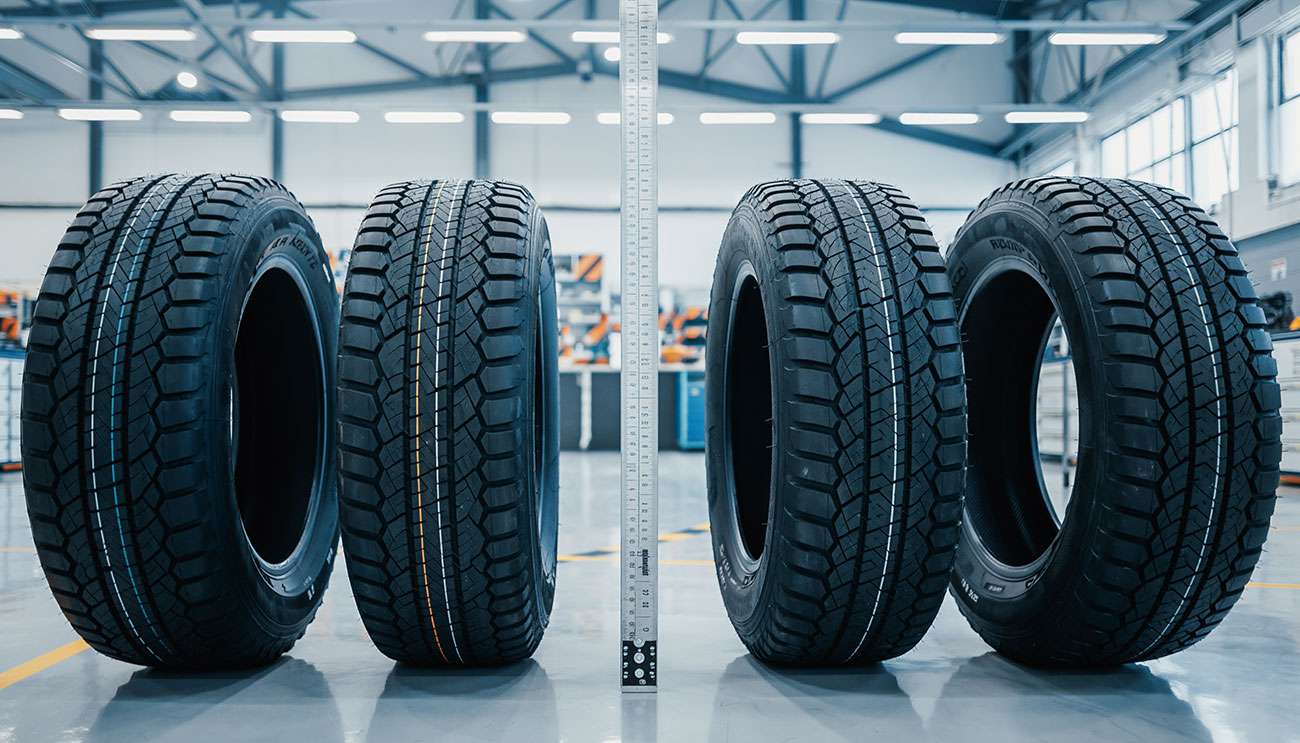
Are 265/75R16 the same as 31x10.5R15? These popular truck tire sizes look similar on paper, but they have important differences that affect your vehicle's performance. The 265/75R16 measures 31.6 inches in overall diameter, while the 31x10.5R15 comes in at 30.6 inches — creating a 2.2% difference in circumference. That one-inch difference impacts how your truck handles, how accurate your speedometer reads, and even your fuel economy.
The width measurements stay close — 10.4 inches versus 10.5 inches — but the 265/75R16 delivers a larger circumference at 99.4 inches compared to the 31x10.5R15's 96.3 inches. Your speedometer feels this difference directly. When your gauge shows 60 mph with the smaller 31x10.5R15 tires, you're actually traveling at 58.1 mph. The revolutions per mile tell the story: 637 for the 265/75R16 versus 658 for the 31x10.5R15.
Choosing the right tire size for your truck depends on your specific vehicle, driving conditions, and what you need from your tires. We'll break down exactly how these measurements affect fuel economy, off-road performance, and daily driving to help you make the best choice for your truck.
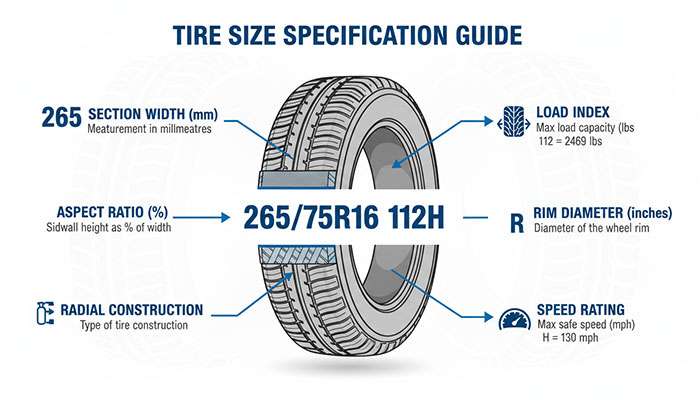
Understanding tire measurements means looking at how these two sizes differ across key dimensions. The 265/75R16 uses metric measurements — width in millimeters, aspect ratio, and rim diameter — while 31x10.5R15 uses imperial measurements for overall diameter, width, and rim diameter.
The 265/75R16 delivers an overall diameter of 31.6 inches, placing it in the large diameter tire category. The 31x10.5R15 measures 30.6 inches in diameter. This creates a 2.2% difference between the two sizes. That 0.67-inch difference affects your ground clearance and changes how your truck handles different terrains. Switching to 31x10.5R15 tires reduces your vehicle's ground clearance by 0.67 inches.
Width measurements stay remarkably close between these sizes. The 265/75R16 measures 10.43 inches (265mm) wide, while the 31x10.5R15 spans 10.51 inches (267mm). This minimal 0.08-inch difference represents only 0.8% variance in width. The 265/75R15 functions as less of a flotation tire, with a narrower tread that delivers less rolling resistance for better fuel economy.
Both tire sizes feature nearly identical sidewall heights. The 265/75R16 has a sidewall measuring 7.82 inches, compared to the 31x10.5R15's sidewall of 7.99 inches. This 0.16-inch difference in sidewall height represents about 2.1% variance. The slightly taller sidewall enhances impact absorption, providing more comfortable rides on uneven or rough terrains.
The 265/75R16 has a circumference of 99.43 inches, compared to the 31x10.5R15's 97.32 inches. This 2.11-inch difference represents approximately 2.2% variance. Circumference directly affects how the tire rolls and influences speedometer readings.
The 265/75R16 completes about 637 revolutions per mile, while the 31x10.5R15 makes approximately 658 revolutions per mile. This 3.2% difference impacts both engine RPM and speedometer accuracy. Most tires in the 31-32 inch diameter range complete between 651 and 672 revolutions per mile, putting both options in the large diameter tire category.
The overall diameter difference falls within the acceptable 3% range for safe replacement, making the interchange generally recommended without additional modifications. These dimensional differences still affect your truck's performance in ways we'll examine next.
Swapping between 265/75R16 and 31x10.5R15 tires changes how accurately your speedometer reports your speed. The circumference difference between these sizes creates a noticeable gap between what your speedometer displays and your actual road speed.
Your speedometer counts tire revolutions to calculate speed, not the actual distance you travel. The smaller 31x10.5R15 tire spins more times to cover the same ground as the larger 265/75R16. When your speedometer shows 60 mph with 31x10.5R15 tires, you're actually moving at 58.1 mph. That's a -3.16% error in your speed reading.
Switch from 31x10.5R15 to 265/75R16 tires and the opposite happens. Your speedometer underreports your actual speed. At a displayed 60 mph, you'll actually be traveling at 61.3 mph. Your vehicle's computer still expects the original tire's revolutions per mile, creating this discrepancy.
This speedometer difference shows up at every speed:
At 20 mph indicated: Actual speed with 31x10.5R15 is 19.4 mph
At 40 mph indicated: Actual speed with 31x10.5R15 is 38.7 mph
At 80 mph indicated: Actual speed with 31x10.5R15 is 77.5 mph
At 100 mph indicated: Actual speed with 31x10.5R15 is 96.8 mph
Concerned about these differences? Installing a new speedometer gear offers an inexpensive fix to recalibrate your readings. This becomes important for maintenance scheduling since your odometer will also count miles slightly faster with the dimensional change.
Your cruise control uses the same wheel rotation data as your speedometer. It holds the indicated speed, not your true speed. Set your cruise to 65 mph with 31x10.5R15 tires and you'll maintain an actual speed of roughly 63.6 mph.
This means adjusting your cruise settings for highway driving. On interstate highways with 70 mph speed limits, you might need to set your cruise to 72 mph to maintain actual legal speed with 31x10.5R15 tires.
Newer vehicles with 16-inch tires have ABS systems calibrated for specific rotation speeds. Switching to 31x10.5R15 tires might trigger traction control warning lights during hard braking. The system may interpret the different rotation speeds as wheel slip.
The 265/75R16 tire travels farther with each rotation than the 31x10.5R15. This makes your actual speed about 2.1% less than what your speedometer shows when using the smaller 31-inch tires.
Tire size changes create a domino effect on your truck's engine performance. Changing between 265/75R16 and 31x10.5R15 tires shifts how hard your engine works at highway speeds and how your transmission performs.
The smaller 31x10.5R15 tire forces your engine to spin faster to maintain the same road speed. With a common 3.73 gear ratio, cruising at 65 mph requires 2,659 RPM with 31x10.5R15 tires. Switch to 265/75R16 tires and that same 65 mph drops to 2,574 RPM. That's an 85 RPM difference between the two sizes.
Your engine makes approximately 3.3% more revolutions with the 31x10.5R15 tires at any given speed. Over thousands of highway miles, those extra revolutions add up to more wear on engine components and higher fuel consumption.
Smaller tires effectively change your gear ratios. Going from 265/75R16 to 31x10.5R15 creates the same effect as installing a numerically higher rear axle gear ratio. Your truck accelerates quicker from a stop with the smaller tires because the effective gear ratio becomes shorter.
The tradeoff comes during highway cruising. Higher engine RPM means your transmission stays in a lower gear longer during acceleration. This affects both fuel economy and the long-term durability of transmission components.
At 75 mph highway speeds with a 3.73 gear ratio:
265/75R16 tires: Engine runs at 2,971 RPM
31x10.5R15 tires: Engine runs at 3,068 RPM
That 97 RPM difference becomes noticeable on long highway trips. Your engine operates in a less efficient range with the smaller tires, burning more fuel and generating slightly more heat.
Highway towing presents even bigger differences. Under load at 65 mph with 31x10.5R15 tires, your engine spins 85 more times per minute than with 265/75R16 tires. This matters when you're climbing mountain passes with a trailer.
Trucks with lower numerical gear ratios (like 3.08 or 3.21) feel the impact more. The RPM difference gets magnified because the engine already turns fewer revolutions per mile. Adding smaller tires compounds this effect.
Conversely, trucks with higher numerical ratios (4.10 or 4.56) already run higher RPMs. The difference between tire sizes becomes less noticeable but still affects fuel economy.
Most factory calibrations assume specific tire sizes. Changing from 265/75R16 to 31x10.5R15 alters the relationship between your speedometer, engine RPM, and actual road speed. Some drivers prefer recalibrating their speedometer to maintain accurate readings.
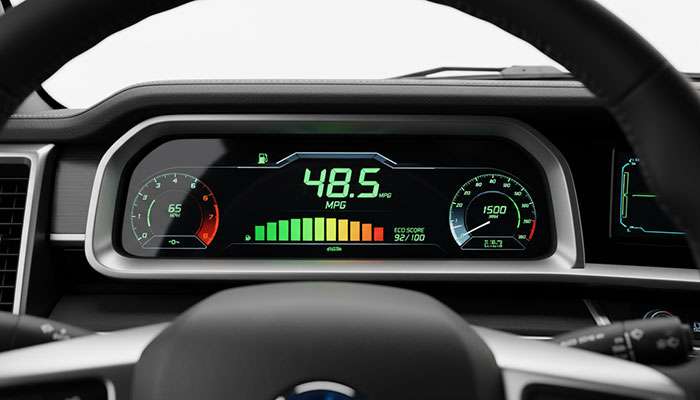
Your tire choice directly impacts how many miles you get per gallon. The 265/75R16 and 31x10.5R15 create different fuel consumption patterns based on their rolling resistance and engine RPM requirements.
The 265/75R16 typically delivers better fuel economy than the 31x10.5R15. The narrower contact patch reduces rolling resistance, letting your truck roll more freely. This translates to less work for your engine and better gas mileage on highway drives.
Switching from 265/75R16 to 31x10.5R15 tires may decrease your fuel efficiency by approximately 3.3%. That means if you're getting 20 MPG with 265/75R16 tires, you might see closer to 19.3 MPG with 31x10.5R15 tires.
Highway driving shows the biggest fuel economy difference between these sizes. The 265/75R16's lower RPM requirements at cruising speeds mean your engine operates in its most efficient range. At 65 mph, your engine spins 85 fewer times per minute with 265/75R16 tires compared to 31x10.5R15.
City driving sees smaller differences. The constant acceleration and braking masks some of the rolling resistance benefits. The 31x10.5R15's wider tread creates more drag, but stop-and-go traffic means you're rarely maintaining steady speeds where this matters most.
Over 15,000 miles of annual driving, the fuel economy difference adds up. With gas at $3.50 per gallon and a baseline 18 MPG:
265/75R16 tires: Approximately $2,917 per year in fuel costs
31x10.5R15 tires: Approximately $3,014 per year in fuel costs
That's roughly $97 per year in extra fuel costs with the 31x10.5R15 tires. Over five years of ownership, you'd spend about $485 more on gas with the wider tires.
Tire pressure plays a crucial role regardless of size. Under-inflated tires increase rolling resistance for both sizes. The 31x10.5R15's larger air volume might require more frequent pressure checks to maintain optimal inflation.
Tread pattern affects efficiency too. Aggressive all-terrain or mud-terrain patterns create more rolling resistance than highway-oriented designs. This impact exists with both tire sizes but becomes more pronounced with the wider 31x10.5R15.
Weight differences between tire brands and models also influence fuel economy. Some 31x10.5R15 tires weigh 5-10 pounds more than comparable 265/75R16 options. That rotating mass requires more energy to accelerate and maintain speed.
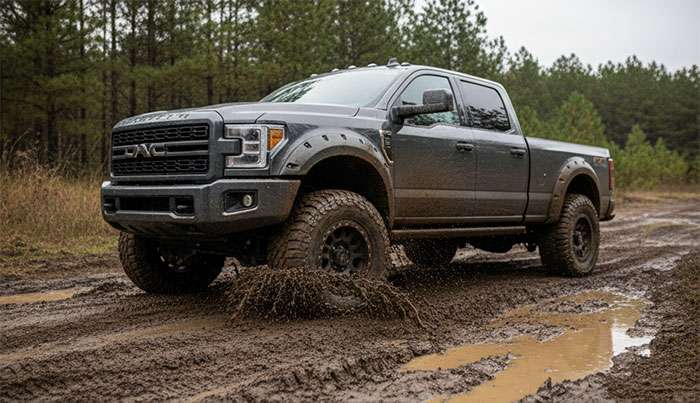
Off-road capability separates these two tire sizes in distinct ways. The 31x10.5R15 edges ahead for serious trail riding and mud performance, while the 265/75R16 holds advantages in certain terrain conditions.
The 31x10.5R15's slightly wider footprint creates better flotation in mud and sand. That extra 0.08 inches of width helps prevent sinking in soft terrain. Mud tires in the 31x10.5R15 size typically feature more aggressive tread patterns that clear debris effectively.
The 265/75R16 can still handle soft sand and deep snow well. Its narrower profile sometimes lets it cut through to firmer ground beneath, rather than riding on top of loose material. This characteristic helps in certain snow conditions where you want the tire to dig down rather than float.
Ground clearance makes a difference on rocky trails. The 265/75R16's extra inch of diameter lifts your differential and axles higher off obstacles. That 0.67-inch increase in ground clearance helps you clear rocks and logs that might catch on lower-riding trucks.
The 31x10.5R15's lower profile sits closer to the rim. This reduces the risk of sidewall damage on sharp rocks. The slightly shorter sidewall also provides more stable handling on off-camber trails where body roll matters.
Both sizes deliver similar traction on hard-packed dirt and gravel roads. The real differences emerge in extreme conditions:
Deep mud: 31x10.5R15 wins with better flotation
Rocky terrain: 265/75R16 provides more ground clearance
Loose sand: 31x10.5R15 offers slightly better flotation
Snow: 265/75R16 can cut through to grip underneath
The 31x10.5R15 tires sit lower on the rim, potentially providing better clearance against upper control arms during full suspension articulation. This matters when you're flexing your suspension on challenging trails.
The 265/75R16's larger diameter means you might need to trim fender liners or install a small lift kit on some trucks. The taller tire creates more potential for rubbing during full steering lock or suspension compression.
Airing down improves traction on both sizes. The 31x10.5R15's larger air volume means you can run slightly lower pressures without risking rim damage. This creates a larger contact patch for better grip on rocks and uneven surfaces.
The 265/75R16 still works well at reduced pressures. Its narrower width maintains sidewall stability even when aired down to 15-20 PSI for trail riding. The key difference comes in how much air volume each size holds and how that affects the contact patch shape.
Load capacity ratings and towing performance differ between these tire sizes based on their construction and dimensions. Understanding these differences helps you match the right tire to your truck's work requirements.
Most 265/75R16 tires carry load index ratings between 116-123, supporting 2,756 to 3,417 pounds per tire. The 31x10.5R15 typically shows load index ratings of 109-115, handling 2,271 to 2,679 pounds per tire.
This means a set of four 265/75R16 tires rated at 121 supports up to 13,448 pounds total vehicle weight. Four 31x10.5R15 tires at a 113 load index handle up to 11,244 pounds. That's a 2,204-pound difference in maximum load capacity.
The 265/75R16 maintains better towing stability due to its larger diameter and typically higher load ratings. When you're pulling a 7,000-pound trailer, the 265/75R16's lower engine RPM at highway speeds translates to better fuel economy while towing.
At 65 mph with a 3.73 gear ratio while towing:
265/75R16 tires: Engine runs at 2,574 RPM under load
31x10.5R15 tires: Engine runs at 2,659 RPM under load
That 85 RPM difference means your engine works harder over long towing distances with the smaller 31x10.5R15 tires. More RPM creates more heat, potentially affecting transmission temperatures on mountain grades.
Trucks rated for higher payload typically come factory-equipped with LT-rated tires in the 265/75R16 size. The construction of these tires includes reinforced sidewalls and stronger internal belts designed for heavy loads.
The 31x10.5R15 works fine for moderate payloads and weekend hauling. Just verify your specific tire's load rating matches your truck's requirements. Some 31x10.5R15 tires feature lighter construction focused on off-road performance rather than maximum load capacity.
Heavier loads demand more from your braking system. The 265/75R16's larger diameter creates a longer braking distance compared to 31x10.5R15 when carrying maximum payload. This happens because the larger tire effectively increases the leverage on your braking system.
The difference becomes noticeable when towing trailers without electric brakes. The 31x10.5R15's smaller diameter provides slightly better mechanical advantage for your brake system, though modern trucks compensate well with ABS and brake assist features.
The 265/75R16 delivers more stable towing characteristics on highways. Its larger contact patch and lower engine RPM help maintain steady speeds without constant throttle adjustments. This reduces trailer sway, especially in crosswinds.
The 31x10.5R15 can handle towing duties effectively on shorter trips and local hauling. For regular long-distance towing of heavy trailers, the 265/75R16's combination of higher load ratings and better fuel economy makes it the practical choice.
How your truck rides and handles changes noticeably between these tire sizes. The differences affect everything from daily commuting comfort to high-speed stability on highways.
The 31x10.5R15's slightly taller sidewall (7.99 inches versus 7.82 inches) absorbs bumps and road imperfections more effectively. This extra 0.16 inches of sidewall height provides better impact absorption over potholes and rough pavement.
The 265/75R16's marginally shorter sidewall creates a firmer ride. You'll feel more road feedback through the steering wheel and seats. This translates to better handling precision during cornering but slightly less comfort over broken pavement.
The 265/75R16 delivers more responsive steering at highway speeds. The narrower width reduces wandering in rutted highway lanes. Your truck tracks straighter with less correction needed to maintain lane position.
The 31x10.5R15's wider footprint creates more surface contact. This increases steering effort at low speeds but provides excellent stability during highway cruising. The wider tire resists crosswinds better than the narrower 265/75R16.
Sharp turns reveal handling differences between these sizes. The 265/75R16's taller overall diameter and narrower width create more responsive turn-in. Your truck feels more agile changing directions quickly.
The 31x10.5R15 rolls slightly more during hard cornering due to the taller sidewall relative to width. This isn't a safety concern for normal driving, but enthusiastic drivers notice the difference. The wider tire does provide a larger contact patch during turns, improving grip on dry pavement.
Tire noise depends heavily on tread pattern rather than size alone. However, the 31x10.5R15's wider tread typically generates slightly more road noise at highway speeds. The additional contact area creates more tread block movement and air pumping.
The 265/75R16 runs quieter in most applications, especially with highway-oriented tread patterns. The narrower footprint reduces the total tread surface interacting with pavement, decreasing overall noise levels.
For daily commuting and city driving, the 31x10.5R15 offers marginally better comfort. The taller sidewall soaks up expansion joints, speed bumps, and parking lot transitions more smoothly.
The 265/75R16 works better for drivers who prioritize precise handling over maximum comfort. The firmer sidewall provides better feedback about road conditions and more predictable responses to steering inputs.
Rain handling favors the 265/75R16's narrower width. The tire cuts through standing water more effectively, reducing hydroplaning risk. The smaller contact patch creates higher pounds-per-square-inch loading, helping the tread dig through water to reach dry pavement.
The 31x10.5R15 provides better snow traction when fitted with appropriate winter tread patterns. The wider footprint helps in deep snow conditions, though the 265/75R16's ability to cut through to harder surfaces beneath works well in certain winter scenarios.
How these tire sizes wear over time affects both their lifespan and your long-term costs. Several factors influence wear rates between 265/75R16 and 31x10.5R15 tires.
The 265/75R16 typically delivers longer tread life in highway applications. The narrower contact patch reduces total rubber touching the pavement, decreasing wear rates during normal driving. Most quality 265/75R16 tires last 50,000-70,000 miles with proper rotation and maintenance.
The 31x10.5R15's wider tread creates more surface contact, accelerating wear on paved roads. Expect 45,000-60,000 miles from these tires in primarily highway use. The difference becomes less pronounced if you drive mostly on dirt roads or trails where different wear factors dominate.
Both tire sizes benefit from regular rotation every 5,000-7,000 miles. The 265/75R16's narrower width sometimes shows more uneven wear if you neglect rotations. The concentrated contact patch creates higher pressure per square inch, accelerating wear in specific tread areas.
The 31x10.5R15 distributes weight across a wider area, potentially wearing more evenly between rotations. However, the extra width makes these tires more susceptible to edge wear if your alignment isn't perfect or if you corner aggressively.
The 265/75R16 commonly develops center wear with over-inflation or edge wear with under-inflation. The narrower profile makes proper tire pressure critical for even wear. Check pressures monthly and maintain manufacturer recommendations.
The 31x10.5R15 shows different wear characteristics. The wider tread tends toward shoulder wear, especially on trucks used primarily for highway driving. This happens because the weight distribution changes when cornering, putting extra stress on the tire's outer edges.
Highway driving favors the 265/75R16 for longevity. The lower rolling resistance and narrower contact patch mean less friction and heat generation. Less heat translates directly to slower compound degradation and longer tire life.
Off-road use tips the balance differently. The 31x10.5R15's wider tread and slightly taller sidewall handle trail obstacles better, reducing the risk of sidewall damage. Rock punctures and trail debris affect both sizes, but the 31x10.5R15's construction often proves more durable in extreme off-road conditions.
Calculate true tire costs by dividing total price by expected mileage. If 265/75R16 tires cost $180 each and last 60,000 miles, that's $0.012 per mile. If 31x10.5R15 tires cost $190 each and last 50,000 miles, that's $0.015 per mile.
Over 100,000 miles of ownership:
265/75R16 tires: Approximately $1,200 in tire costs (1.67 sets)
31x10.5R15 tires: Approximately $1,520 in tire costs (2 sets)
These calculations assume similar tire quality and driving conditions. Your actual costs vary based on specific tire brands, driving habits, and road conditions.
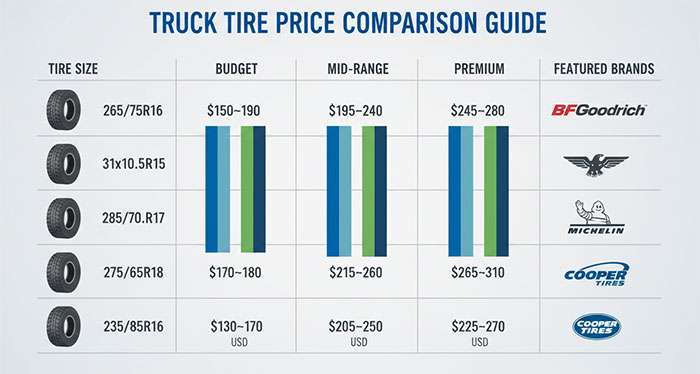
Understanding price differences and market availability helps you budget for your tire purchase. Both sizes offer good selection, though pricing and options vary significantly.
The 265/75R16 typically costs between $150-$280 per tire for quality all-terrain options. Highway-oriented models start around $130, while premium mud-terrain tires reach $300 or more. The size's popularity among truck manufacturers keeps prices competitive.
The 31x10.5R15 generally runs $160-$290 per tire in comparable categories. You'll find entry-level options starting at $140, with top-tier off-road models exceeding $320. The imperial sizing sometimes commands slight premiums due to specialized manufacturing.
Major tire manufacturers produce extensive 265/75R16 selections. You'll find options from:
BFGoodrich All-Terrain T/A KO2
Goodyear Wrangler series
Michelin LTX A/T2
Falken Wildpeak A/T3W
Cooper Discoverer AT3
The 31x10.5R15 offers fewer but still solid choices. Popular options include various all-terrain and mud-terrain patterns from established brands. The selection focuses more on off-road performance rather than highway touring designs.
Both tire sizes see price fluctuations throughout the year. Spring and fall bring the best deals as retailers clear inventory for seasonal changes. Black Friday and holiday sales often feature 265/75R16 tires due to their mainstream popularity.
The 31x10.5R15 experiences less dramatic seasonal pricing. Its more specialized market means steadier year-round pricing, though you can still find occasional manufacturer rebates and dealer promotions.
Local tire shops stock 265/75R16 tires readily. The size's popularity means most retailers keep multiple brands and models in inventory. This availability gives you leverage for price matching and negotiation.
The 31x10.5R15 requires more shopping around. Specialty off-road shops typically offer better selection than general tire retailers. Online ordering often provides wider choices and competitive pricing for this size.
Factor in total ownership costs when comparing prices. The 265/75R16's better fuel economy saves approximately $97 annually in gas costs. Over a 50,000-mile tire lifespan, that's roughly $270 in fuel savings offsetting any initial price premium.
The 31x10.5R15's potentially shorter tread life on highways affects long-term value. If you replace these tires every 45,000 miles versus 60,000 miles for 265/75R16, you'll buy tires more frequently despite similar per-tire costs.
Installation costs stay similar between sizes. Most shops charge identical labor rates for mounting and balancing both options. Factor in alignment services if you're changing tire sizes, as this ensures even wear and optimal handling.
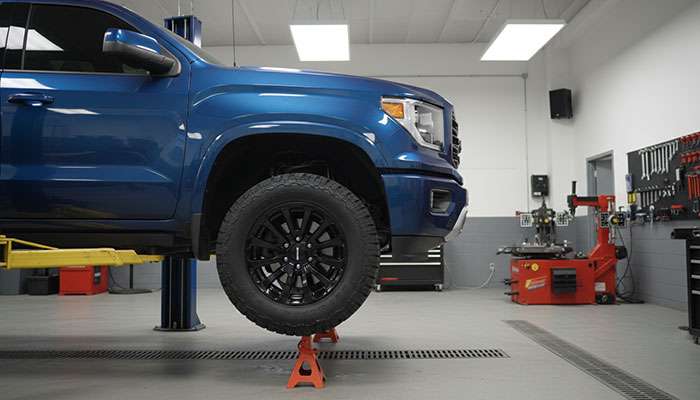
Understanding tire compatibility and which vehicles work with these tire sizes helps you make the right choice for your truck. Both 265/75R16 and 31x10.5R15 fit specific vehicle applications, and knowing the details ensures proper fitment.
You'll find 265/75R16 tires as original equipment on many pickup trucks and SUVs. Popular applications include:
Chevrolet Silverado 1500 (1999-2006)
Ford F-250 (1973-1979)
GMC Sierra 1500 (1999-2006)
Hummer H3 (2005-2010)
Land Rover Defender (1983-2016)
Nissan Pathfinder (2005-2012)
RAM 1500 (2015-2018)
Toyota FJ Cruiser (2010-2014)
We carry quality 265/75R16 tires at Performance Plus Tire's selection with competitive pricing and excellent options for your vehicle.
The metric equivalent to 31x10.5R15 is 265/75R15. This conversion matters when you're shopping different tire brands that use metric versus imperial measurement systems.
Yes, 265/75R15 matches 31x10.5R15 dimensions. Both deliver nearly identical measurements: 30.6 inches overall diameter, 10.4 inches width, and 7.8 inches sidewall height.
The 31x10.5R15 tires sit lower on the rim, potentially providing better clearance against upper control arms. The 31x10.5R15's smaller diameter reduces axle-to-ground height by about 0.34 inches, which might require coil spring spacers for certain off-road applications.
Here's a side-by-side comparison of these two popular tire sizes to help you understand the key differences:
| Specification | 265/75R16 | 31x10.5R15 | Difference |
|---|---|---|---|
| Overall Diameter | 31.6 inches | 30.6 inches | 2.2% |
| Width | 10.43 inches | 10.51 inches | 0.8% |
| Sidewall Height | 7.82 inches | 7.99 inches | 2.1% |
| Circumference | 99.43 inches | 97.32 inches | 2.2% |
| Revolutions per Mile | 637 | 658 | 3.2% |
| Actual Speed at 60 mph indicated | 61.3 mph | 58.1 mph | 3.2 mph |
| RPM at 65 mph (3.73 gear ratio) | 2,574 | 2,659 | +85 RPM |
| Fuel Economy | Better | Lower (-3.3%) | 3.3% |
| Best Usage | City driving, highway commuting, towing | Off-road, mud, sand | N/A |
| Measurement System | Metric | Imperial | N/A |
The choice between 265/75R16 and 31x10.5R15 tires comes down to how you use your truck. These tire sizes might look similar, but the 265/75R16's larger 31.6-inch diameter versus the 31x10.5R15's 30.6-inch diameter creates real differences in fuel economy, speedometer accuracy, and driving performance.
For daily driving, highway commuting, and towing, the 265/75R16 typically delivers better results. You'll get improved fuel economy, more responsive handling, and maintain your truck's factory-designed gear ratios. Performance Plus Tire offers an extensive selection of high-quality 265/75R16 tires with competitive pricing and excellent options for these driving conditions.
The 31x10.5R15 works better if off-road performance tops your priority list. Just remember that your speedometer will read about 2 mph higher than your actual speed, and your engine will work slightly harder at highway speeds.
Both tire sizes fall within the safe 3% replacement threshold, so either choice works mechanically. The decision depends on whether you prioritize fuel efficiency and on-road performance or off-road capability and ride comfort. Consider your driving terrain, load requirements, and vehicle specifications when making your final choice. Understanding these differences ensures you select the tire size that matches your truck's performance needs and your driving habits.
Understanding the differences between 265/75R16 and 31x10.5R15 tires helps you choose the right size for your truck's specific needs and driving conditions.
265/75R16 tires are 1 inch larger in diameter (31.6" vs 30.6"), creating a 2.2% difference that affects speedometer accuracy and ground clearance.
Speedometer readings differ by 3.2% - at 60 mph indicated, 31x10.5R15 tires actually travel 58.1 mph while 265/75R16 tires travel 61.3 mph.
265/75R16 delivers better fuel economy due to lower rolling resistance, while 31x10.5R15 may decrease MPG by approximately 3.3%.
Choose 265/75R16 for daily driving and towing - offers superior highway performance, fuel efficiency, and maintains factory gear ratios.
31x10.5R15 works better for off-road conditions but requires higher engine RPM at highway speeds (85 more RPM at 65 mph with 3.73 gear ratio).
Both tire sizes fall within the safe 3% replacement threshold, making either option viable depending on whether you prioritize fuel efficiency and on-road performance or off-road capability and ride comfort.
The main difference is in overall diameter. 265/75R16 tires are 31.6 inches in diameter, while 31x10.5R15 tires are 30.6 inches. This 1-inch difference affects aspects like speedometer accuracy, ground clearance, and fuel economy.
265/75R16 tires typically offer better fuel economy due to lower rolling resistance. Switching to 31x10.5R15 tires may decrease fuel efficiency by approximately 3.3% because they're wider and create more rolling resistance.
Yes, it will. With 31x10.5R15 tires, your actual speed will be about 3.2% slower than what your speedometer shows. For example, when your speedometer reads 60 mph, you'll actually be traveling at 58.1 mph.
31x10.5R15 tires are generally preferred for off-road conditions due to their slightly wider profile and better flotation in mud and sand. However, 265/75R16 tires can also perform well in soft sand and deep snow.
265/75R16 tires are typically better for highway driving and towing. They maintain factory-designed gear ratios more effectively, provide more responsive acceleration, and offer better fuel economy on paved roads. 31x10.5R15 tires may require higher engine RPM at highway speeds.